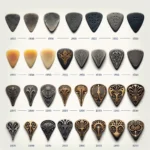Choosing the Right Guitar Pick: A Comprehensive Guide
When it comes to playing the guitar, selecting the right guitar pick is crucial for achieving the desired sound and playability. With a wide variety of options available in terms of materials, shapes, and thickness, choosing the perfect guitar pick can be a daunting task. However, understanding the factors that influence the selection process can make the task easier. This comprehensive guide aims to provide insights into choosing the right guitar pick to suit your playing style and preferences.
One of the fundamental aspects to consider when choosing a guitar pick is the material. Guitar picks are commonly available in materials such as plastic, nylon, celluloid, and metal. Each material offers distinct tonal characteristics and durability. For instance, plastic picks are widely favored for their versatility and bright tonal response, while nylon picks are known for their flexibility and smooth texture. Celluloid picks, on the other hand, are preferred for their warm tone and comfortable grip. Metal picks, although less common, provide a unique sound and are renowned for their durability.
Another vital factor to contemplate is the shape of the guitar pick. Picks come in various shapes, including standard teardrop, jazz, and triangle shapes. The shape of the pick can significantly impact the way you strike the strings and produce sound. Additionally, the thickness of the pick plays a crucial role in determining the attack and response of the guitar. Thinner picks offer more flexibility and are favored for strumming, while thicker picks provide enhanced control and precision, making them suitable for lead playing.
Moreover, personal playing style and genre preferences also play a significant role in selecting the right guitar pick. Players who engage in aggressive strumming or fast lead playing may opt for thicker, sturdier picks to accommodate their playing techniques. Conversely, those who prefer fingerstyle playing or gentler strumming may lean towards thinner, more flexible picks to achieve a softer and more nuanced sound.
In conclusion, choosing the right guitar pick involves considering various factors such as material, shape, thickness, and playing style. Experimenting with different picks and being attentive to the tonal and tactile differences can aid in determining the ideal pick for individual preferences. By understanding the nuances of guitar picks, players can effectively enhance their playing experience and achieve their desired tonal outcomes.
Exploring Different Guitar Pick Materials and Their Impact on Tone
When it comes to exploring different guitar pick materials and their impact on tone, it’s essential for guitarists to understand how the choice of pick can influence the sound produced. The material of a guitar pick can significantly affect the tone, playability, and overall feel of the instrument.
One of the most popular materials for guitar picks is celluloid. Celluloid picks offer a warm and traditional tone, making them a favorite among many guitarists. Their flexibility and smooth surface contribute to their classic sound, especially well-suited for strumming and rhythm playing.
On the other hand, picks made from nylon are known for their durability and bright, articulate tone. Nylon picks are favored by many lead guitarists for their precision and speed due to their stiffer nature.
For those seeking a more modern sound, picks constructed from Delrin or other synthetic materials provide a crisp and bright tone, ideal for cutting through dense mixes and delivering a clear, powerful sound.
For guitarists who prefer a natural, earthy tone, wooden picks are an excellent choice. Wooden picks can produce a soft, warm tone with a unique resonance, making them a popular option for acoustic guitar players.
Furthermore, metal picks, often made from stainless steel or brass, offer a bright and sharp tone with exceptional durability. While they may not be the first choice for every guitarist, they can add a distinctive edge to the sound when used selectively.
In conclusion, the choice of guitar pick material plays a crucial role in shaping the tone and playability of the instrument. By exploring the sonic characteristics of different pick materials, guitarists can fine-tune their sound and find the perfect match for their playing style and musical preferences.
Mastering Your Technique: Tips for Using Guitar Picks Efficiently
Mastering your technique with guitar picks is essential for achieving great sound and control while playing the guitar. Here are some tips to help you use guitar picks efficiently:
- Choose the right pick: Selecting the right pick for your playing style and the type of music you want to play is crucial. Thinner picks are ideal for strumming, while thicker picks work well for lead guitar playing.
- Hold the pick properly: Grip the pick firmly between your thumb and index finger, with a small protrusion of the pick sticking out. This allows for better control and precision while playing.
- Practice alternate picking: Mastering the technique of alternate picking (down-up strokes) will improve your speed and accuracy. Start slow and gradually increase your speed as you become more comfortable.
- Experiment with angles: Explore different angles at which you hold the pick against the strings. Adjusting the angle can produce variations in tone and attack, allowing you to create diverse sounds.
- Relax your grip: Tensing up while holding the pick can lead to stiffness and decreased dexterity. Keep your grip relaxed to allow for fluid movements and better overall control.
- Focus on precision: Aim to strike the strings cleanly and consistently. Practice precision by targeting individual strings and mastering your accuracy.
By implementing these tips and practicing regularly, you can enhance your guitar playing technique and maximize the efficiency of using guitar picks.




